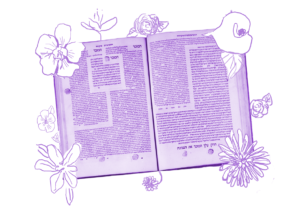Representations of Jewish culture in American popular culture typically take the form of bagels and cream cheese and matzah ball soup from Eastern Europe, not the Yemenite kubaneh bread and spicy chili schug of my grandma and my childhood, or the foods and cultures of other Middle Eastern and North African Jews, or of Jews from other parts of Asia and Africa.
The majority of North American Jews are of European Ashkenazi origins, and the typical college student in this country — such as those I teach — typically experiences and imagines Jews in this way. But these representations are limiting and inaccurate. We need to understand ourselves and help others understand us as a diverse people containing multiple and intersecting ethnic and racial identities.
In a global Jewish population of about 16 million individuals there are several hundred thousands of Ethiopian Jews; over three million Jews originating in North African countries including Morocco, Tunisia, Algeria, Libya, and Egypt; several million with Mizrachi Middle Eastern/Southwest Asian heritage hailing from Syria, Lebanon, Bahrain, Yemen, and Iraq; as well as large communities from Iran, India and Central Asia. In several American and Canadian cities there are large communities of Jews from non-European backgrounds – such as Persian Jews in Los Angeles. There are Syrian and Middle Eastern Jews from Yemen and North Africa and Bukharan Jews from the Central Asian countries of Uzbekistan, Tajikistan, Turkmenistan, and Kyrgyzstan in New York City; Latino Jews in Miami and Los Angeles; Sephardi Jews hailing from Spain, Turkey, and Greece in Seattle; and Moroccan Jews in Montreal.
Of course, being Ashkenazi of European origins does not protect Jewish people from being targets of hate crimes – as is often mistakenly assumed. Jewish people face social, professional, and other forms of prejudice and discrimination on the basis of Jewish identity. Visibly Jewish individuals – whatever their ethnicity – are particularly at risk of abuse. This includes Orthodox and Ultra-Orthodox Jews whose dress and kippa head covering makes them instantly recognizable as Jews. It also includes Jews who wear a Star of David or other form of Jewish expression and visible identification, irrespective of their expressions of Jewish religious observance.That is true today and has been true through centuries of persecution of Jewish people in Europe and other parts of the world, where Jews were persecuted primarily for being a religious and ethnic minority, as well as being perceived as a separate race.
Historically, Jewish experiences of persecution impacted Middle Eastern and North African Jews in ways that are not commonly understood in the United States and Canada. Anti-Jewish Nazi persecution reached the Jews of Libya, Algeria, and Tunisia during the Holocaust. Over 800,000 Jews from North Africa and Middle Eastern countries faced persecution, expulsion, dispossession and displacement over several decades of communal calamity between the 1940s and the 1970s and became refugees.
Many Jewish communities experienced violence and mass killing in the form of pogroms, such as Iraq’s Farhud in 1941. Similar massacres took place primarily in the 1940s and 1950s in Yemen, Morocco, Algeria, Syria, Egypt and other parts of the Middle East and North Africa with large Jewish communities.
All of these experiences of inequality, injustice, persecution and flight created profound forms of harm and loss to Jewish people and their legacies are deeply felt today.
In the United States there are Asian Jewish, Black Jewish, and Latino Jewish communities as well as Native American Jews. These communities are growing, and the American Jewish community is and continues to be one increasingly characterized by diversity and multiplicities of identities.
Rabbi Angela Buchdahl, for example, who leads the Central Synagogue in New York City, is Korean American.
Rabbi Jacqueline Mates-Muchin, the Senior Rabbi at Temple Sinai of Oakland, is Chinese American.
Samson Nderitu Njogu, a Kenyan, is a rabbinic intern at San Francisco’s Beth Shalom synagogue while studying at the Ziegler School of Rabbinic Studies in L.A.
Shoshana Nambi, a Ugandan from the Abayudaya community, is an assistant rabbi at Congregation Beth Am of Los Altos in the Bay Area.
Michael Twitty is Black and Jewish and has written extensively about those intersecting identities and how they relate to food cultures.
The African American mayor of San Francisco, London Breed, has recently spoken about her Jewish heritage at a Bay Area Moishe House.
The new President of Mexico, Claudia Sheinbaum, is a Jewish Latina. In many congregations and communities in the United States Jews who identify as Latin American serve as rabbis and lay leaders, such as Rabbi Roly Matalon of B’nai Jeshurun in New York City.
There are some countries, including France and Israel, where Jews from North Africa and the Middle East make up the majority of the country’s Jewish population. Indeed, the majority of Jewish Israelis hail from North African and Middle Eastern countries as well as Ethiopia, Iran and India.
There are still other countries where the entire Jewish population is Latino or Lusophone, such as Argentina, Uruguay, Peru, Colombia, Venezuela, Chile, Mexico and Brazil.
More than 700,000 Jews are Hispanic. Approximately half of them live in the United States, where their community continues to grow. In the United States, Jewish Puerto Ricans have long lived in Puerto Rico and contributed to it. Some Jews found refuge from the Holocaust in the Dominican Republic.
To do justice to the diversity of the Jewish experience and the Jewish people and to be inclusive of Jewish people, American universities and American society need to recognize that Jewish Americans and Jewish people globally are ethnically, racially, historically and culturally a mosaic. Recognizing and appreciating Jewish diversity and the extent to which Jews are people of color will not end hate against Jews, anti-Jewish stereotypes and abuse, and racist exclusion of and discrimination against Jewish people on the basis of their Jewish beliefs, identity, origins, and practices. Anti-Jewish bigotry is a painful, long, and deeply embedded part of American and Canadian society and culture on college campuses and well beyond.
Its recent increase in prevalence and intensity reveals that like a virus it can become largely dormant in its severity for extended periods of time – even for decades – only to return with disturbing force and harmful consequences to Jewish people first and foremost, as we are now experiencing. It also negatively impacts American and Canadian society as a whole and the liberal democratic principles of freedom, equality, justice, and human dignity which are necessary for insuring the rights of minorities and all citizens.
Recognizing and celebrating Jewish diversity is an important first step to greater understanding the experiences of Jewish people and their many different cultures and ethnicities historically and today, and how Jewish people both manifest diversity and contribute to it.
Noam Schimmel is a Lecturer in Global Studies with an emphasis on human rights at University of California, Berkeley.




